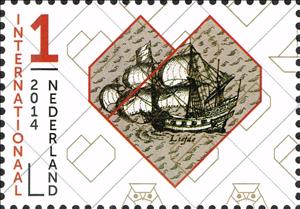Stamp: Sailing ship "De Liefde" (Netherlands 2014)
Sailing ship "De Liefde" (Netherlands 2014)
14 July (Netherlands ) within release Boundless Netherlands - Japan goes into circulation Stamp Sailing ship "De Liefde" face value 1 No Face Value
| Stamp Sailing ship "De Liefde" in catalogues | |
|---|---|
| Michel: | Mi:NL 3255 |
| NVPH: | NVP:NL 3202 |
Stamp is horizontal format.
Also in the issue Boundless Netherlands - Japan:
- Stamp - Itsuki Gentaku (17757-1827), Dutch Studies face value 1;
- Stamp - Philipp Franz von Siebold (1796-1866) physician & Japan expl face value 1;
- Stamp - "The Mistress", painting by Vincent van Gogh face value 1;
- Stamp - "Girl in Red Kimono" painting by G.H. Breitner face value 1;
- Stamp - Sailing ship "De Liefde" face value 1;
- Stamp - Dejima face value 1;
- Souvenir Sheet - Boundless Netherlands - Japan: trade face value 6*1;
- Souvenir Sheet - Boundless Netherlands - Japan: science face value 6*1;
- Souvenir Sheet - Boundless Netherlands - Japan: art face value 6*1;
Stamp Sailing ship "De Liefde" it reflects the thematic directions:
A ship is a large watercraft that travels the world's oceans and other sufficiently deep waterways, carrying passengers or goods, or in support of specialized missions, such as defense, research and fishing. Historically, a "ship" was a sailing vessel with at least three square-rigged masts and a full bowsprit. Ships are generally distinguished from boats, based on size, shape and load capacity.
Trade involves the transfer of goods and services from one person or entity to another, often in exchange for money. Economists refer to a system or network that allows trade as a market.
A modern sailing ship or sailship is any large wind-powered vessel. Traditionally a sailing ship (or simply ship) is a sailing vessel that carries three or more masts with square sails on each. Large sailing vessels that are not ship-rigged may be more precisely referred to by their sail rig, such as schooner, barque (also spelled "bark"), brig, barkentine, brigantine or sloop. There are many different types of sailing ships, but they all have certain basic things in common. Every sailing ship has a hull, rigging and at least one mast to hold up the sails that use the wind to power the ship. The crew who sail a ship are called sailors or hands. They take turns to take the watch, the active managers of the ship and her performance for a period. Watches are traditionally four hours long. Some sailing ships use traditional ship's bells to tell the time and regulate the watch system, with the bell being rung once for every half hour into the watch and rung eight times at watch end (a four-hour watch). Ocean journeys by sailing ship can take many months, and a common hazard is becoming becalmed because of lack of wind, or being blown off course by severe storms or winds that do not allow progress in the desired direction. A severe storm could lead to shipwreck, and the loss of all hands. Sailing ships are limited in their maximum size compared to ships with heat engines, so economies of scale are also limited. The heaviest sailing ships (limited to those vessels for which sails were the primary means of propulsion) never exceeded 14,000 tons displacement. Sailing ships are therefore also very limited in the supply capacity of their holds, so they have to plan long voyages carefully to include many stops to take on provisions and, in the days before watermakers, fresh water.



